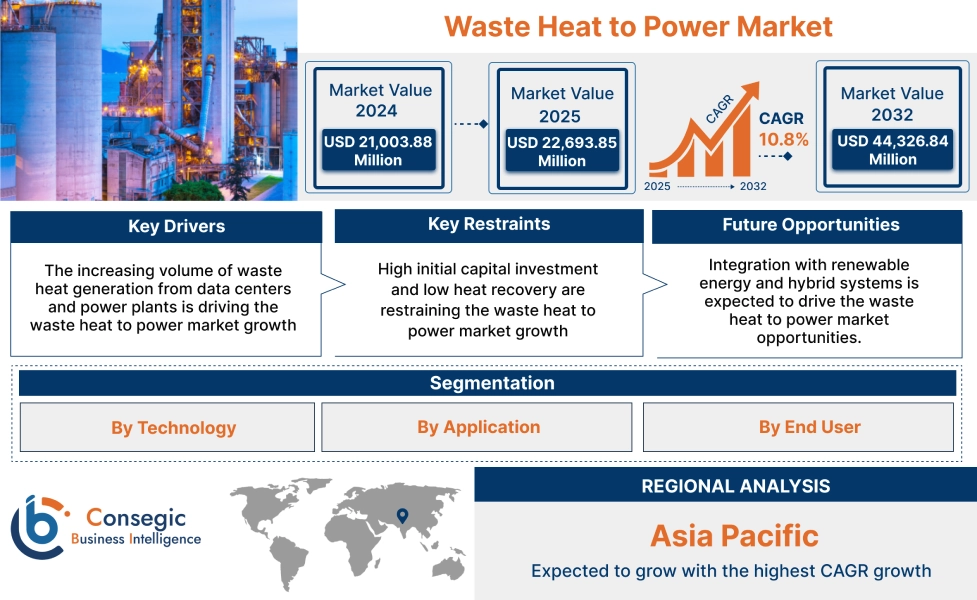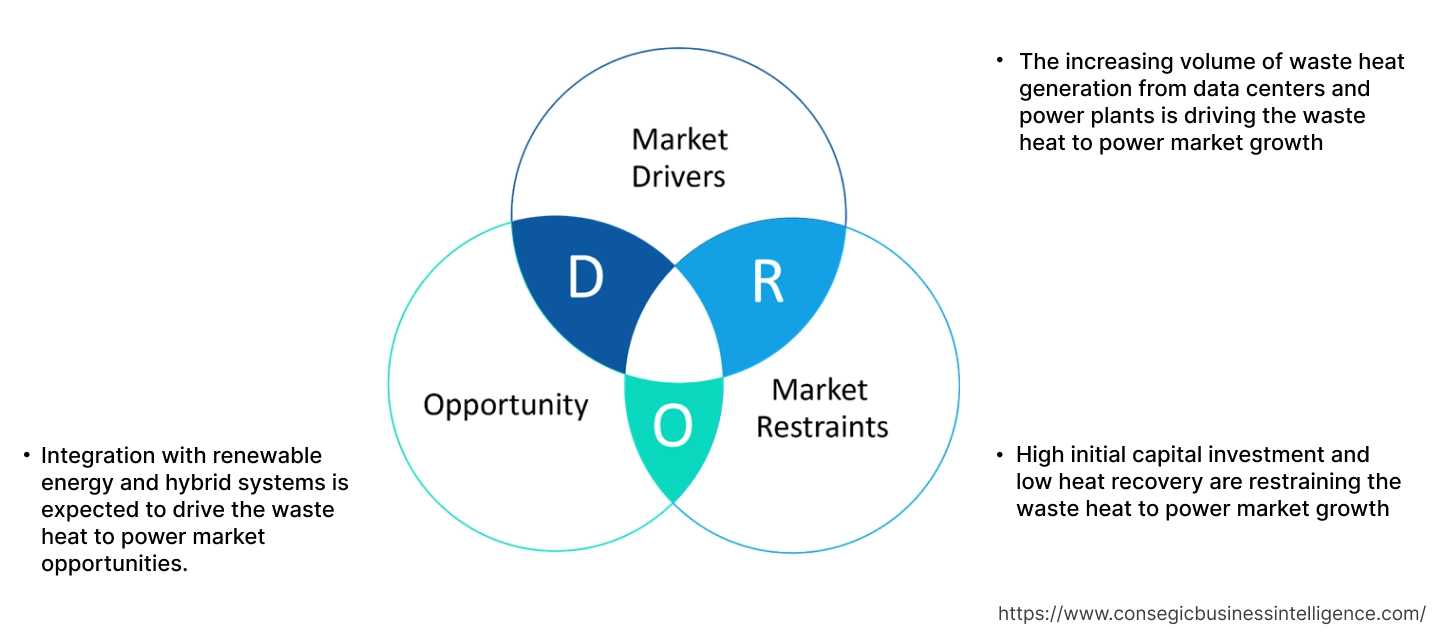Waste Heat to Power Market Size:
Waste Heat to Power Market size is estimated to reach over USD 44,326.84 Million by 2032 from a value of USD 21,003.88 Million in 2024 and is projected to grow by USD 22,693.85 Million in 2025, growing at a CAGR of 10.8% from 2025 to 2032.
Waste Heat to Power Market Scope & Overview:
Waste heat to power (WHP) refers to the process of converting waste heat, which is discarded from industrial processes or thermal activities, into electricity. Moreover, the captured heat is further used to generate power through various technologies such as steam rankine cycle system, organic rankine cycle systems, and others. In addition, the electricity generated by waste heat can be used on-site for internal consumption or can be sold back to the grid. Additionally, the development and implementation of waste heat to power technologies helps in reducing the overall environmental footprint.
How is AI Transforming the Waste Heat to Power Market?
AI is transforming the waste heat to power (WHP) market by optimizing energy recovery, operational efficiency, and system reliability. Through advanced data analytics, AI monitors temperature variations, flow rates, and equipment performance in real time to maximize heat-to-energy conversion. Machine learning models predict system inefficiencies and recommend adjustments to improve overall power output. AI also supports predictive maintenance by identifying potential failures in turbines, heat exchangers, or generators before downtime occurs. Additionally, AI-driven simulations help design more efficient WHP systems tailored to industrial applications. By reducing energy waste and improving sustainability, AI is playing a pivotal role in advancing the global adoption of waste heat to power technologies across manufacturing and energy-intensive industries.
Waste Heat to Power Market Dynamics - (DRO) :
Key Drivers:
The increasing volume of waste heat generation from data centers and power plants is driving the waste heat to power market growth
Waste heat-to-power in data centers and power plants involves recovering the excess heat generated by servers and various equipment and then using that heat to produce electricity. Moreover, the heat generated from this process can be utilized to heat nearby buildings through a district heating system. Additionally, the integration of waste heat-to-power solutions in data centers and power plants contributes to sustainability by significantly reducing energy consumption and lowering the carbon footprint of energy.
- For instance, the U.S. data centers consume almost 2% of the U.S. total electricity. Moreover, waste heat-to-power technologies are often utilized in data centers to convert waste heat-to-power for improving sustainability in data center operations.
Hence, according to the analysis, the growing demand for waste heat to energy solutions in data centers and power plants is driving the waste heat to power market size.
Key Restraints:
High initial capital investment and low heat recovery are restraining the waste heat to power market growth
Waste heat recovery is a process of capturing and reusing the energy which will be discarded if not in use. However, the cost of installing and maintaining waste heat to power equipment is relatively expensive. Moreover, the quality of heat waste is a major factor that determines the feasibility and effectiveness of the systems. Additionally, the energy is often dispersed and diluted, particularly from sources like cooling water and exhaust gases, which require advanced technologies to convert it into electricity. Implementation of advanced technologies is costly, specifically for the industries that are focused on short-term financial gains. Therefore, high initial capital investment and low heat recovery are restraining the waste heat to power market demand.
Future Opportunities :
Integration with renewable energy and hybrid systems is expected to drive the waste heat to power market opportunities.
Integration of renewable energies and hybrid systems plays a crucial role in improving sustainability in waste heat to power technologies. Moreover, utilizing waste heat with renewable sources such as solar thermal, wind power, and others enhances the overall efficiency of the systems. Additionally, combined heat and power systems are used to generate electricity and useful thermal energy, which can be optimized by waste heat recovery.
- For instance, Tata Power utilizes a waste heat recovery system to convert waste heat into electricity. Moreover, waste heat from the blast furnace and coke oven gas is converted into energy to reduce environmental effects and improve sustainability.
Thus, the increasing advancements related to waste heat-to-power solutions, such as integration with renewable energy and hybrid systems, are projected to drive the waste heat to power market opportunities during the forecast period.
Waste Heat to Power Market Segmental Analysis :
By Technology:
Based on technology, the market is segmented into steam rankine cycle, organic rankine cycle, kalina technology, and others.
Trends in the technology:
- Rising trend in adoption of steam rankine cycle to convert thermal energy into electrical power is driving the market growth.
- Factors such as rising adoption for renewable energy, technological advancements, and improved efficiency are driving the waste heat to power market size.
Steam rankine cycle segment accounted for the largest revenue share of 45.28% in the overall waste heat to power market share in 2024.
- Steam rankine cycle is one of the main power generating methods that transforms large-scale thermal energy into usable power.
- Moreover, the steam rankine cycle encompasses four components such as vapour generator, device, condenser, and feed pump.
- Additionally, superheating steam is a crucial step in steam rankine cycle to improve the cycle’s efficiency and reduce the moisture content at the turbine exit.
- For instance, Engineering Lab China offers rankine cycle steam turbine in its product offerings, with various features such as an independently certified boiler, low volume feed pump, pressure gauges, and others.
- Therefore, according to the analysis, rising advancements related to the steam rankine cycle segment are driving the waste heat to power market.
Organic rankine cycle segment is anticipated to register fastest CAGR growth during the forecast period.
- Organic rankine cycle is a thermodynamic method that utilizes organic fluid to convert heat energy into power.
- Moreover, ORC is highly effective in low and medium temperature heat sources.
- Additionally, organic rankine cycle method facilitates various advantages such as low temperature heat recovery, versatile working fluids, environmental benefits, and others, which are further propelling the market trends.
- For instance, Turboden offers organic rankine cycle solutions which offer various benefits such as flexibility, advanced technology, sustainability, and longer life span. Moreover, Turboden’s ORC system operates without the need for water and organic fluid to drive the power generation.
- Thus, the increasing advancements related to organic rankine cycle system are expected to propel the waste heat to power market expansion during the forecast period.
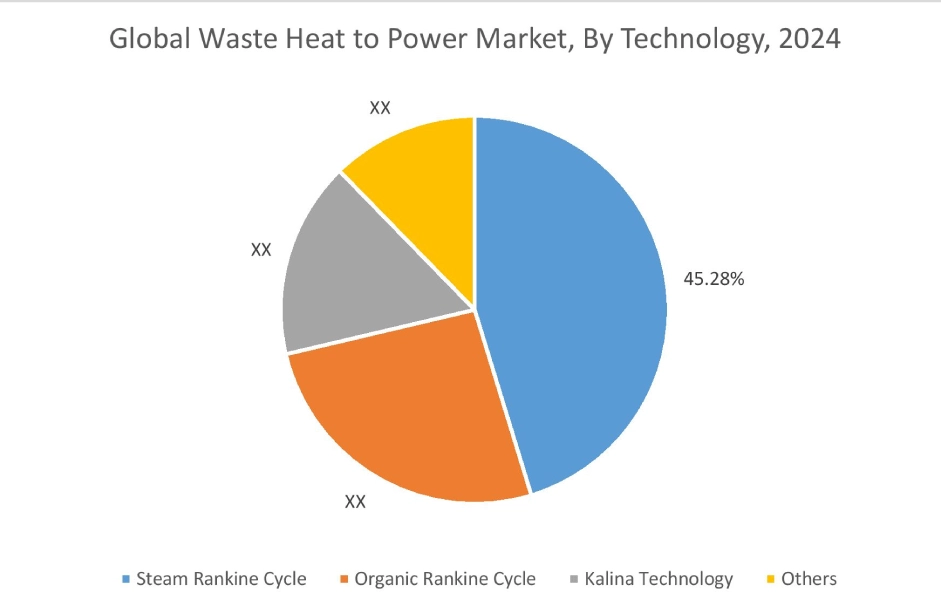
By Application:
Based on application, the market is segmented into power generation, district heating, combined heat and power, and others.
Trends in the application:
- Rising utilization of combined heat and power due to factors such as an increasing demand for energy efficiency, renewable energy integration, and reduced fuel consumption is driving the market.
- Increasing adoption of waste heat-to-power technologies due to various factors, such as increased power production, reduced emissions, and environmental benefits, is driving the waste heat to power market expansion.
Combined heat and power segment accounted for the largest revenue share in the overall waste heat to power market share in 2024, and it is anticipated to register significant CAGR growth during the forecast period.
- Combined heat and power requires a single energy source to generate electricity and useful thermal energy, such as heat.
- Moreover, combined heat and power is utilized in various production processes such as processing food, manufacturing, textile, and others.
- Additionally, various advanced technologies such as micro combined heat and power and organic rankine cycles are utilized in combined heat and power, which improves efficiency and expands the range of applications.
- For instance, according to the U.S. Department of Energy, combined heat and power applications operate at 75% efficiency than any traditional system.
- Therefore, rising advancements related to the combined heat and power segment are driving the waste heat to power market trends.
By End User:
Based on end user, the market is segmented into petroleum refining, oil and gas, cement, heavy metal, chemical, and others.
Trends in the end user:
- Rising demand and adoption of waste heat-to-power technologies in the petroleum refining sector are boosting the waste heat to power market.
- Increasing trend in adoption of waste heat-to-power technologies in the oil and gas sector for improved energy efficiency, reduced operational costs, and maximized environmental impact is driving the market.
Petroleum refining segment accounted for the largest revenue in the overall market in 2024.
- Waste heat-to-power solutions in petroleum refinery involve converting the energy from heat waste stream to generate power through turbine.
- Moreover, various processors such as distillation and thermal cracking produce a significant amount of waste heat, which is converted into power through steam turbine generators.
- Additionally, converting waste heat-to-power offers several benefits in petroleum refining, such as increased fuel efficiency, decreased environmental impacts, and others.
- For instance, Reliance Industries Limited, a multinational conglomerated based in India, implemented advanced waste heat recovery systems at its Jamnagar petroleum refinery. Moreover, the advanced waste heat recovery system captures heat from exhaust gas and utilizes it to generate steam, which is further used to enhance overall energy efficiency.
- Therefore, the above benefits of waste heat-to-power are increasing its adoption in petroleum refineries, thereby driving the waste heat to power market trends.
Oil and gas segment is anticipated to register fastest CAGR growth during the forecast period.
- Waste heat in oil and gas sector is extracted from various processors such as turbines, engines, and others, which is utilized to generate additional power.
- Moreover, advanced technologies such as organic rankine cycle, steam rankine cycle, and others are utilized to convert waste heat into electrical power.
- For instance, the Indian Oil Corporation Limited (IOCL), an India-based oil company, implemented waste heat recovery systems in its Mathura refinery. Moreover, the waste heat from recovery solutions helps IOCL improve efficiency by reducing operational costs and decreasing greenhouse emissions.
- Hence, the growing oil and gas sector is projected to increase the utilization of waste heat-to-power technologies to improve sustainability, reduce energy cost, and reduce emissions, which in turn is projected to drive the market during the forecast period.
Regional Analysis:
The regions covered are North America, Europe, Asia Pacific, the Middle East and Africa, and Latin America.
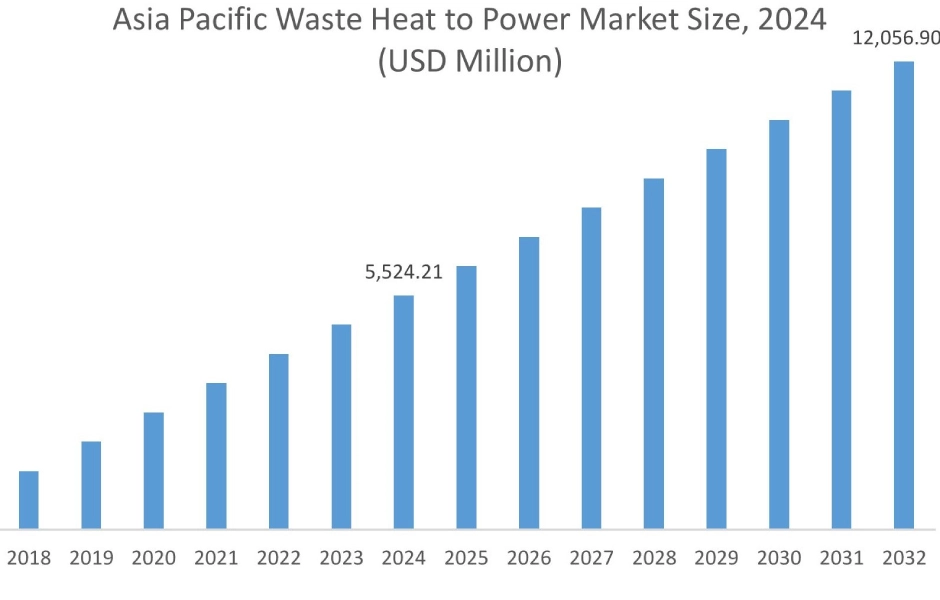
Asia Pacific region was valued at USD 5,524.21 Million in 2024. Moreover, it is projected to grow by USD 5,985.69 Million in 2025 and reach over USD 12,056.90 Million by 2032. Out of this, China accounted for the maximum revenue share of 36.59%. As per the waste heat to power market analysis, the adoption of waste heat-to-power solutions in the Asia-Pacific region is primarily driven by the growing petroleum refining, oil and gas, and cement sectors, among others. Additionally, the growing combined heat and power sector is further accelerating the waste heat to power market, due to various factors such as energy efficiency, fuel savings, and environmental benefits, among others.
- Forinstance, UltraTech Cement, a multinational cement company based in Mumbai, India, implemented waste heat recovery power plants (WHRPP) to reduce its reliance on grid electricity.
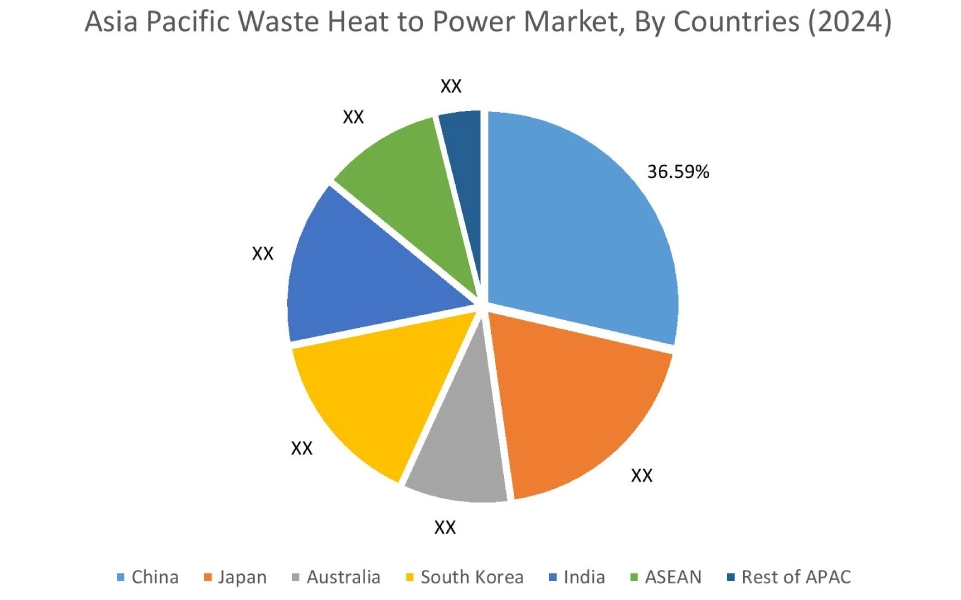
North America is estimated to reach over USD 15,071.13 Million by 2032 from a value of USD 7,151.03 Million in 2024 and is projected to grow by USD 7,725.52 Million in 2025. In North America, the growth of waste heat to power industry is driven by the growing investments in petroleum refinery, oil and gas, and other sectors. As per the waste heat to power market analysis, the increasing adoption of steam rankine cycle in the petroleum refining and chemical sectors is further contributing to the waste heat to power market growth.
- For instance, in January 2023, Chevron New Energies , Raven SR Inc., and Hyzon Motors Inc. announced their collaboration to improve the business operations of a green waste to hydrogen production facility to supply hydrogen fuels to the transportation market. Moreover, this project produces 60% of its electricity by waste heat from zoned landfill gas generators at the landfill to reduce air emissions and fulfill the need for grid power for its non-combustion process.
Additionally, the regional analysis depicts that the growing petroleum refinery, increasing development of oil and gas facilities, and rising investments in the adoption of cement factories are driving the waste heat to power market demand in Europe. Furthermore, as per the market analysis, the market demand in Latin America, Middle East, and African regions is expected to grow at a considerable rate due to factors such as increasing advancements related to petroleum refining, along with growing oil & gas, chemical, and other sectors.
Top Key Players and Market Share Insights:
The global waste heat to power market is highly competitive with major players providing solutions to the national and international markets. Key players are adopting several strategies in research and development (R&D), product innovation, and end-user launches to hold a strong position in the waste heat to power market industry. Key players in the waste heat to power industry include-
- Orcan Energy AG (Germany)
- NewHeat (France)
- Helix Energy Solutions Group Inc. (U.S.)
- Transparent Energy Systems Private Ltd (India)
- Terrapin Geothermics (Canada)
- ABB (Switzerland)
- Alfa Laval AB (Sweden)
- Atlas Copco Actiebolag (Sweden)
- Enertime (France)
- Enerdrape (France)
Recent Industry Developments :
Initiative:
- In April 2025, NTT Data Center announced to improve waste heat from Berlin 1 data center located in Spandau. Moreover, this initiative provides various benefits such as support of decentralization, reduction of environmental impact through scalable use of waste heat and utilization of existing infrastructure to avoid additional energy demand.
Waste Heat to Power Market Report Insights :
| Report Attributes | Report Details |
| Study Timeline | 2019-2032 |
| Market Size in 2032 | USD 44,326.84 Million |
| CAGR (2025-2032) | 10.8% |
| By Technology |
|
| By Application |
|
| By End User |
|
| By Region |
|
| Key Players |
|
| North America | U.S. Canada Mexico |
| Europe | U.K. Germany France Spain Italy Russia Benelux Rest of Europe |
| APAC | China South Korea Japan India Australia ASEAN Rest of Asia-Pacific |
| Middle East and Africa | GCC Turkey South Africa Rest of MEA |
| LATAM | Brazil Argentina Chile Rest of LATAM |
| Report Coverage |
|
Key Questions Answered in the Report
How big is the waste heat to power market? +
The waste heat to power market was valued at USD 21,003.88 Million in 2024 and is projected to grow to USD 44,326.84 Million by 2032.
Which is the fastest-growing region in the waste heat to power market? +
Asia-Pacific is the region experiencing the most rapid growth in the waste heat to power market.
What specific segmentation details are covered in the waste heat to power report? +
The waste heat to power report includes specific segmentation details for technology, application, end user, and region.
Who are the major players in the waste heat to power market? +
The key participants in the waste heat to power market are Orcan Energy AG (Germany), ABB (Switzerland), Alfa Laval AB (Sweden), Atlas Copco Actiebolag (Sweden), Enertime (France), Enerdrape (France), NewHeat (France), Helix Energy Solutions Group Inc. (U.S.), Transparent Energy Systems Private Ltd (India), Terrapin Geothermics (Canada) and others.
